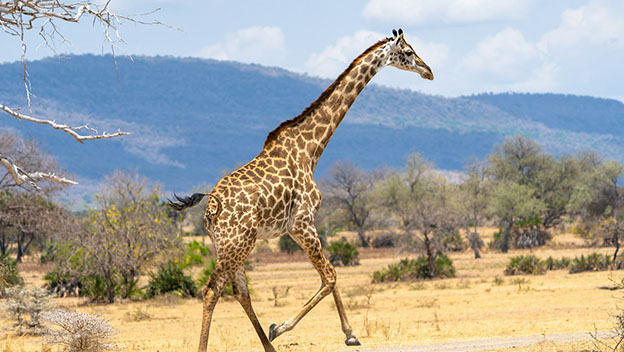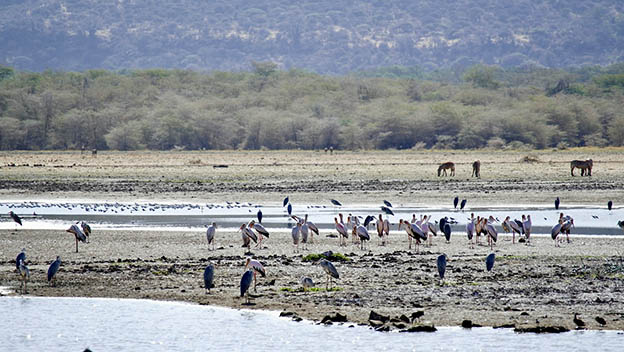Tanzania is enormous, with diverse landscapes that house fascinating national parks where nature and wildlife are preserved. A visit to this East African gem is a call to endless adventures and wildlife safaris in the vast wilderness, and its national parks hold some of its best wonders. National Parks can be best paired with some of the Best Walking Adventures in Tanzania, including trekking Mount Kilimanjaro (the ‘Roof of Africa’). These are the top 7 national parks you need to visit to witness wonders like the famous wildebeest migration and the African Big 5.

Photo credit: Kai Putter
1. Serengeti National Park
The Serengeti National Park has no rivalry in East Africa and the entire continent. At 14,763 square kilometres (5,696 square miles), it is one of the largest national parks in Tanzania and home to a staggering 4 million diverse animals. The park is exclusively for wildlife preservation but features a massive ecosystem that embodies the Masai Mara Reserve in Kenya, the Maswa Game Reserve, and a part of the Ngorongoro Conservation Area. The park's highlight is the annual Great Migration of thousands of Wildebeest and zebras across Tanzania's vast savannah to Kenya, and it gets dramatic when they cross the Mara River. It is one of the world's best wildlife sights, with 1.5 million wildebeest, 400,000 zebras, and 200,000 gazelles migrating across East Africa yearly. Discover our holidays in the Serengeti National Park.

Photo credit: Ray Rui
2. Arusha National Park
Arusha National Park is the smallest in the country at just 135 square kilometres (52 square miles) but big on attractions and wonders. The park is home to abundant wildlife, such as giraffes, zebras, buffaloes, elephants, and warthogs. Beyond wildlife, the park incorporates natural geological spectacles like Mount Meru, a 4,566-metre (14,980-foot) volcano and the second-highest peak in Tanzania. The Jekukumia River runs through the Meru Crater on its west corner, the green pastures of Ngurdoto Crater lie on its southeast flank, and the alkaline Momella lakes lie on its Northeast corner. And it doesn't end there. The park is framed by the imposing elegance of Mount Kilimanjaro, which is just 60 kilometres (37 miles) away.

Photo credit: Aron Marinelli
3. Nyerere National Park
Named after the country's first president and political legend, Julius Nyerere, this is the largest national park in Tanzania at 30,893 square kilometres (11,928 square miles). It’s so massive that it’s larger than 70 countries and well protected with no permanent residences. The park is also home to Tanzania's largest river, Rufiji, which many crocodiles and hippos call home. The Selous Game Reserve is now part of the park, and combined, they house some of the world's largest herd of elephants. Beyond its outstanding diversity of wildlife, Nyerere Park is one of the world's largest mangrove forests in its delta.

Photo credit: Elizabeth Morgan
4. Ngorongoro Conservation Area
The Ngorongoro Conservation Area was named after the Ngorongoro Crater, the world's largest caldera. Designated as a UNESCO World Heritage Site in 1980, the crater is a marvel and is home to diverse wildlife that makes it look like a caldera zoo. The 8,292 square kilometre (3206 square miles) area has one of the highest densities of lions at 62 in 2001 while being home to other wildlife such as Wildebeest, Cheetah, Rhinoceros, and Zebras. Visitors can also explore the Ngorongoro Crater Lake, including the Olduvai Gorge, one of the world's remarkable paleoanthropological sites that has informed many researches and findings in human evolution. Explore our bespoke tours in the unique Ngorongoro Crater here.

Photo credit: Ray Rui
5. Lake Manyara National Park
Lake Manyara National Park comprises the northern section of Lake Manyara and its western shore and is home to an incredible diversity of birds and exotic wildlife. Particularly alluring for birdwatchers, the 325 square kilometre (125 square mile) park also stands out for its tree-climbing lions, which you should watch as they sometimes lurk on the branches of trees. Other wildlife in the park include baboons, giraffes, and zebras. While the lake's beauty is enchanting, the park is saturated with flourishing vegetation and an assemblage of tall trees, complementing the lake's picturesque charm.

Photo credit: Daniel Vargas
6. Mount Kilimanjaro National Park
Mount Kilimanjaro needs no introduction and is so remarkable that designating it a national park alongside its neighbouring plains was only natural. At 5,895 metres (19,340 feet), Africa's tallest peak stands in the park, dwarfing everything else in sight, including the village of Moshi, which serves as a muster point. In 2005, the park was expanded to accommodate an entire montane forest, formerly designated as the Kilimanjaro Forest Reserve. Each year, thousands of tourists troop to this and attempt to ascend Uhuru Peak, the mountain's summit. The park is a UNESCO World Heritage Site, a designation it deserves and earned in 1987. If you are looking to conquer the summit of Mount Kilimanjaro, let us help you find the right route for you with our range of Mount Kilimanjaro Treks and Walks.
7. Tarangire National Park
The iconic Tarangire National Park is a fascinating medley of landscapes and wildlife. At 2,850 square kilometres (1,100 square miles). It combines a forest of baobabs and open savannahs with herds of elephants, tree-climbing lions, zebras, Impalas, wildebeest, and Masai giraffes. Visitors can spot these animals on a safari or hike the savannah to wonder at its endless expanse. The Tarangire River that runs through the park is an attractive spot for bird watching as it hosts most of the park's over 500 bird species. There are also termite mounds in the park, but they are mainly home to dwarf mongoose.










